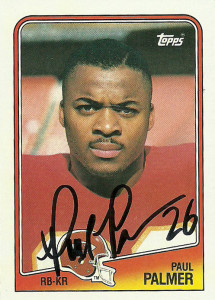 Cards: Topps 1988, Topps 1989, Topps 1989 Traded, Ultimate WLAF 1992, Ultimate WLAF 1992 Promo, ProSet 1989, ProSet WLAF 1992, Action Packed 1990, Score 1989, Score Supplemental 1989
Cards: Topps 1988, Topps 1989, Topps 1989 Traded, Ultimate WLAF 1992, Ultimate WLAF 1992 Promo, ProSet 1989, ProSet WLAF 1992, Action Packed 1990, Score 1989, Score Supplemental 1989
Acquired: TTM 2014, C/o Home
Sent: 5/27 Received: 6/7 (11 days)
Failure: TTM 2013, C/o Temple University
Paul Palmer was a record setting back for the Owls as he singlehandedly put the program in the National spotlight during mid 1980’s. He’d finish as the 1986 Heisman Trophy runner-up to Vinny Testaverde, leading the nation in rushing yards (1,866 yards) and all-purpose yardage (2,633). His improbable 239.4-yard all-purpose average still ranks fifth in college football history, and at the time, Paul’s 349-yards against East Carolina in 1986, was the 4th highest single game rushing yardage in college football history. When he graduated, Paul had set 23 school records and held every major rushing and all-purpose yardage mark. A unanimous All-American selection that year, he was also named the 1986 East Coast Athletic Conference Player of the Year.
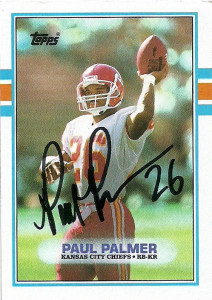 The 1987 NFL draft was stacked with amazing runningback talent and recognizable names that were to change the playing field. Among the other names in this draft were: Alonzo Highsmith, Brent Fullwood, DJ Dozier, Terrance Flagler, Christian Okoye, Steve Smith, Jamie Mueller, Timmy Smith, Tommie Agee, Meril Hoge, and even the second stab at Bo Jackson. In hindsight however, most of the names in this group became solid contributors to their position and only situational starters. The Kansas City Chiefs drafted Palmer with the 19th overall pick. He’d be the 4th back to come off the board after Highsmith, Fullwood, and Dozier. Unlike his predecessors, Palmer was small, speedy, and shifty tailback. The Chiefs then selected powerback Christian Okoye in Round 2. Paul had a pretty solid rookie season. He led the AFC with 38 returns for 938 yards, a gaudy 24.3 return average, and scored a Touchdown in the opener against San Diego, and then later in Week 15 against
The 1987 NFL draft was stacked with amazing runningback talent and recognizable names that were to change the playing field. Among the other names in this draft were: Alonzo Highsmith, Brent Fullwood, DJ Dozier, Terrance Flagler, Christian Okoye, Steve Smith, Jamie Mueller, Timmy Smith, Tommie Agee, Meril Hoge, and even the second stab at Bo Jackson. In hindsight however, most of the names in this group became solid contributors to their position and only situational starters. The Kansas City Chiefs drafted Palmer with the 19th overall pick. He’d be the 4th back to come off the board after Highsmith, Fullwood, and Dozier. Unlike his predecessors, Palmer was small, speedy, and shifty tailback. The Chiefs then selected powerback Christian Okoye in Round 2. Paul had a pretty solid rookie season. He led the AFC with 38 returns for 938 yards, a gaudy 24.3 return average, and scored a Touchdown in the opener against San Diego, and then later in Week 15 against
the Seahawks. To illustrate how monumental his achievement was, no Chief had led the AFC in returns since Dave Grayson way back in 1961, when the Chiefs were known as the Dallas Texans. In total, Palmer had 1,105 all-purpose yards in 1987.
 The Chiefs started Paul in 11 games in 1988, using him creatively as a receiver both in the flat and out of the backfield, but Palmer got suspended for conduct detrimental to the team, after he was involved in an argument with coach Frank Gansz’s staff. At the time Paul’s yards from scrimmage were second in the NFL to only Eric Dickerson. He’d be suspended for two games, and return to play, but only marginally. With less of an emphasis on returning kicks, Paul had 53 receptions for 611 yards and 4 TDs, while also contributing for 452 yards and 2 touchdowns. Again, he cracked the 1,000 yard barrier with 1,427 all-purpose yards. After the season, the Chiefs fired the staff and brought in Marty Schottenheimer, who did not feel that Palmer fit his system.
The Chiefs started Paul in 11 games in 1988, using him creatively as a receiver both in the flat and out of the backfield, but Palmer got suspended for conduct detrimental to the team, after he was involved in an argument with coach Frank Gansz’s staff. At the time Paul’s yards from scrimmage were second in the NFL to only Eric Dickerson. He’d be suspended for two games, and return to play, but only marginally. With less of an emphasis on returning kicks, Paul had 53 receptions for 611 yards and 4 TDs, while also contributing for 452 yards and 2 touchdowns. Again, he cracked the 1,000 yard barrier with 1,427 all-purpose yards. After the season, the Chiefs fired the staff and brought in Marty Schottenheimer, who did not feel that Palmer fit his system.
In 1989, Palmer was cut by the Chiefs and signed with Detroit. Moving to a Run ‘N Shoot format, Detroit hoped to use him in relief of Barry Sanders out of the backfield, or as a receiver, but he was relegated to just being a return man. That’s when Palmer became a part of one of the biggest megatrades in NFL history. With the Cowboys struggling and looking to change things up, they decided to trade Herschel Walker for a bevvy of draft choices and players, to 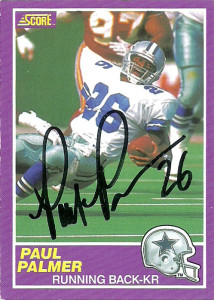 the Minnesota Vikings. The problem was, it left a gaping hole at runningback. No problem there as the Vikings were willing to trade Darrin Nelson to the Cowboys, but Darrin didn’t want to play for the hapless Cowboys and refused to report. Uh oh, we have a problem. So the Cowboys traded Nelson to San Diego, and the Lions traded Paul Palmer to the Cowboys for an 8th round pick.
the Minnesota Vikings. The problem was, it left a gaping hole at runningback. No problem there as the Vikings were willing to trade Darrin Nelson to the Cowboys, but Darrin didn’t want to play for the hapless Cowboys and refused to report. Uh oh, we have a problem. So the Cowboys traded Nelson to San Diego, and the Lions traded Paul Palmer to the Cowboys for an 8th round pick.
Palmer’s time with the Cowboys was during a turmoltuous time in the history of the franchise. Rookie head coach Jimmy Johnson was replacing longtime favorite Tom Landry, and then Paul Palmer was replacing Herschel at runningback. To top things off, the team had a controversy between two equally young and ineffective rookie quarterbacks (at the time) in Troy Aikman and Steve Walsh. Palmer’s first game in a Cowboy uniform was ironically against his old team- the Kansas City Chiefs. While the Cowboys lost, 38-26, Palmer put on a show rushing for 85 yards and a touchdown on 9 carries, and catching 5 passes for 30 yards and a touchdown. While the papers lamented the Cowboys’ woeful ways, they were
at least moderately confident that the running game was in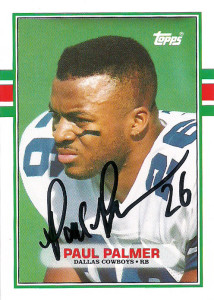 the respectable hands of Paul Palmer.
the respectable hands of Paul Palmer.
In Week 7 of the season, Dallas was riding into Washington on a 0-6 record. Now the important part of that sentence is that “Dallas was riding INTO Washington.” You see the Cowboys and Redskins had this weird history of beating each other on their opposing home turf. So the Redskins would win in Dallas and the Cowboys…. would find a way to win in Washington. Palmer had the best game in his NFL career, rushing for 110 yards on 18 carries and a touchdown. (In another stroke of
irony, Paul has revealed in later interviews that he grew up a Redskin fan and cheered against any team that beat the Cowboys. Then he found himself playing for them, which changed his tune.) Paul’s heroics though was overshadowed, by not only the sheer relief that Dallas fandom felt in getting that one win under their belt, but by the fact that it was Steve Walsh, and not Troy Aikman, who was the signal caller that was under center. The next week Paul had a career high 22 carries against the Cardinals, but the Cowboys would not win again for the remainder of the 1989 season. He’d finish the year with a team leading 446 yards and 2 touchdowns rushing.
finish the year with a team leading 446 yards and 2 touchdowns rushing.
Paul was one and done with the Dallas Cowboys, perhaps by the play of his biteless offensive line, (as he failed to gain at least 20 yards in 4 games during the backhalf of the season,) or that the team sat him in the final contest in favor of Broderick Sargent and Daryl Johnston. -You see if he hit 500 yards, the squad would have owed him a bonus. Paul thought nothing of it, and felt he was going to be a part of the turnaround that the team was going to experience. In fact, assistant coach Butch Davis told him so. He’d be left unprotected by the squad after the season. Snubbed by the Cowboys, he signed with the Cincinnati Bengals. It probably is of no comfort that for Paul’s Cowboy career, he is relegated to being the footnote between Herschel Walker and Emmitt Smith.
In 1990, Palmer looked forward to new scenery with the Bengals, but with a stacked backfield of Ickey Woods, James Brooks, and rookie Harold Green, Palmer failed to make the squad. Palmer was 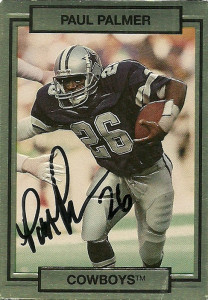 often misused by NFL teams at the time. At 5’9″, 180, he was too small to be used as a 3 down back or as a heavy workhorse. His future lied in the field today that is occupied by guys like Darren Sproles- but then with the whole bruhaha that occurred in KC when he got labeled a bad teammate, – odds were just stacked against Paul in the NFL.
often misused by NFL teams at the time. At 5’9″, 180, he was too small to be used as a 3 down back or as a heavy workhorse. His future lied in the field today that is occupied by guys like Darren Sproles- but then with the whole bruhaha that occurred in KC when he got labeled a bad teammate, – odds were just stacked against Paul in the NFL.
In 1991, Paul was eager to prove his critics wrong and get back to playing football, and the fledgling WLAF provided that opportunity for him to get back on solid footing. He was genuinely excited for the league draft. He wouldn’t have to wait long as the Barcelona Dragons drafted Paul in the first round of the league’s positional draft with the third pick. Head coach Jack Bicknell believed in Paul, and through the 4th game of the season, he ranked 2nd in the WLAF with 319 yards on 76 carries, including a 133 yard effort against Raleigh-Durham. An injured hamstring limited his effectiveness throughout the remainder of the season, but he still helped the team finish at a strong 8-2 and play in World Bowl I against the London Monarchs. Paul’s performance was strong enough that he’d be  signed by the Philadelphia Eagles after the season ended, but at training camp, his concerns about playing time were blown out of proportion by the media. He did not make the squad.
signed by the Philadelphia Eagles after the season ended, but at training camp, his concerns about playing time were blown out of proportion by the media. He did not make the squad.
Paul enjoyed his time with the Dragons organization and returned to Barcelona in 1992, rushing 88 times for 259 yards. The team won the European Division title but was elimated in the playoffs by the future World Bowl Champion
Sacramento Surge. After the season, the WLAF went on hiatus, not to be seen again, until 1995 , strictly in a European format.
Paul returned to the United States, and was involved in sideline reporting for the Temple Owls from 2001-2004. He then worked at the High School level, coaching football at Haddon Heights. Palmer proved that you can indeed go home, as he has been welcomed back to Temple to handle color analysis for their radio broadcasts in 2013. Paul absolutely deserves merit into the College Football Hall of Fame, especially in this changing landscape of the NCAA today. It was revealed many years ago, that in Paul’s senior 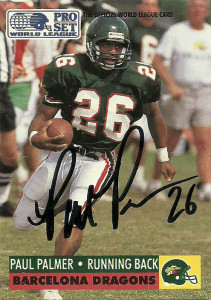 season at Temple, he took a $5,000 interest-free loan from agent Norby Walters. The Owls were harsh in their punishment, stripping him of 16 school records and forfeiting the team’s six wins from the 1986 season in 1989. Still Boo Boo is revered by the Temple faithful, and is still considered quite the legend at the college, where you can’t talk about Heisman hopes without bringing up his name.
season at Temple, he took a $5,000 interest-free loan from agent Norby Walters. The Owls were harsh in their punishment, stripping him of 16 school records and forfeiting the team’s six wins from the 1986 season in 1989. Still Boo Boo is revered by the Temple faithful, and is still considered quite the legend at the college, where you can’t talk about Heisman hopes without bringing up his name.
Palmer had been one of my more frustrating payoffs. After not finding a trace of him on the internet, I threw up a hail mary to Temple, thinking that they might have an alumni association. Unfortunately they sent me back a letter telling me that they didn’t have an alumni department, nor did they know how to locate him. I then decided to put an all points bulletin out for him through Sportscollectors.net, where a kind collector assisted me in locating a working address for me. One of my best responses ever, Paul was certainly worth the wait. I only sent him 4 cards, but he actually added 6 additional signed cards! Of note, one of the cards I had him sign is the rare Ultimate WLAF promo card (with the yellow stripe)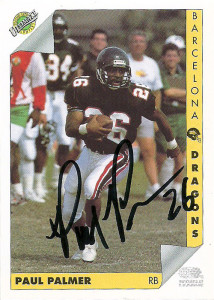 that was given away at the WLAF games in 1992. These 10 cards represent every card pro card of his printed during his tenure in the professional ranks.
that was given away at the WLAF games in 1992. These 10 cards represent every card pro card of his printed during his tenure in the professional ranks.
NFL 41/20 KR 72 Yds 923 Avg 21.4 Td 2 Lg 95t
Rush 270 Yds 1053 Avg 3.9 Td 4 Lg 63
Rec 74 Yds 731 Avg 9.9 Td 4 Lg 71t
WLAF Rush 181 Yds 617 Avg 3.4 Td 2 Lg 26
Rec 14 Yds 161 Avg 11.5 Td 0 Lg 49
Kr 15 Yds 245 Avg 16.3 Td 0 Lg 27